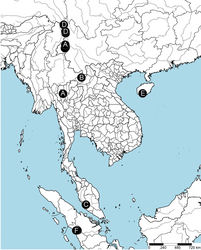Coddingtonia euryopoides
| Notice: | This page is derived from the original publication listed below, whose author(s) should always be credited. Further contributors may edit and improve the content of this page and, consequently, need to be credited as well (see page history). Any assessment of factual correctness requires a careful review of the original article as well as of subsequent contributions.
If you are uncertain whether your planned contribution is correct or not, we suggest that you use the associated discussion page instead of editing the page directly. This page should be cited as follows (rationale):
Citation formats to copy and paste
BibTeX: @article{Feng2019ZooKeys886, RIS/ Endnote: TY - JOUR Wikipedia/ Citizendium: <ref name="Feng2019ZooKeys886">{{Citation See also the citation download page at the journal. |
Ordo: Araneae
Familia: Theridiosomatidae
Genus: Coddingtonia
Name
Coddingtonia euryopoides Miller et al., 2009 – Wikispecies link – Pensoft Profile
- Coddingtonia euryopoides Miller et al., 2009: 30, figs 8B, 11E, F (♀); Lopardo and Hormiga 2015[1]: 734, figs 124A–F, 125A–G, 137D (♀).
Material examined
Holotype ♀ (CASENT 9022403 in HNU) CHINA: Yunnan Province, Longling County, Mangkuan Township, Zaotang He at Baihualing Village, 25°18.27'N, 98°48.04'E, ca. 1635 m, 2 Jun. 2005, good subtropical broadleaf forest, dusting webs in understory, C. Griswold leg.
Other material examined
1♀, 3♂ juv. (NHMSU) CHINA: Yunnan Province: Longling County, Longjiang Town, Xiaoheishan Nature Reserve, 24°49.73'N, 98°45.60'E, ca. 2020 m, 22 Aug. 2018, Y. Lin et al. leg. Of them, 1♂ juv. and 1♀ used for sequencing, same data for preceding, GenBank: MN211317 and MN211316; 1♀ (NHMSU): Baoshan City, Tengchong County, Gudong Town, Jiangdong Village, Jiangdong Hill, Luoshui Cave, 24°58.10'N, 98°52.10'E, ca. 1880 m, 16 Nov. 2013, Y. Li & J. Liu leg.
Diagnosis
The male of C. euryopoides differs from the males of other species by the mesal bristle of the embolic apophysis describing a semi-loop very close to the embolus base and a semi-loop around the bulb, and the straight median apophysis having a tapering tip (Lopardo and Hormiga 2015[1]: fig. 124B, E, F). The female of C. euryopoides can be distinguished from the other five species by having 9 coils of the copulatory ducts (Fig. 1E), whereas other species have fewer coils. Moreover, C. euryopoides differs from C. anaktakun, C. discobulbus, and C. huifengi sp. nov. by having a posterior tubercle on the abdomen (Fig. 1A–C), whereas this tubercle is absent in the latter three species.
Description
See Fig. 1A–F and Miller et al. (2009[2]: 30). Male of this species remains unknown.
Distribution
China (Yunnan) and Thailand (Chiang Mai) (Fig. 6).
Taxon Treatment
- Feng, C; Lin, Y; 2019: Three new species of the genus Coddingtonia from Asia (Araneae, Theridiosomatidae) ZooKeys, 886: 113-126. doi
Images
|
Other References
- ↑ 1.0 1.1 Lopardo L, Hormiga G (2015) Out of the twilight zone: phylogeny and evolutionary morphology of the orb-weaving spider family Mysmenidae, with a focus on spinneret spigot morphology in symphytognathoids (Araneae, Araneoidea).Zoological Journal of the Linnean Society173(3): 527–786. https://doi.org/10.1111/zoj.12199
- ↑ Miller J, Griswold C, Yin C (2009) The symphytognathoid spiders of the Gaoligongshan, Yunnan, China (Araneae, Araneoidea): Systematics and diversity of micro-orbweavers.ZooKeys11: 9–195. https://doi.org/10.3897/zookeys.11.160

